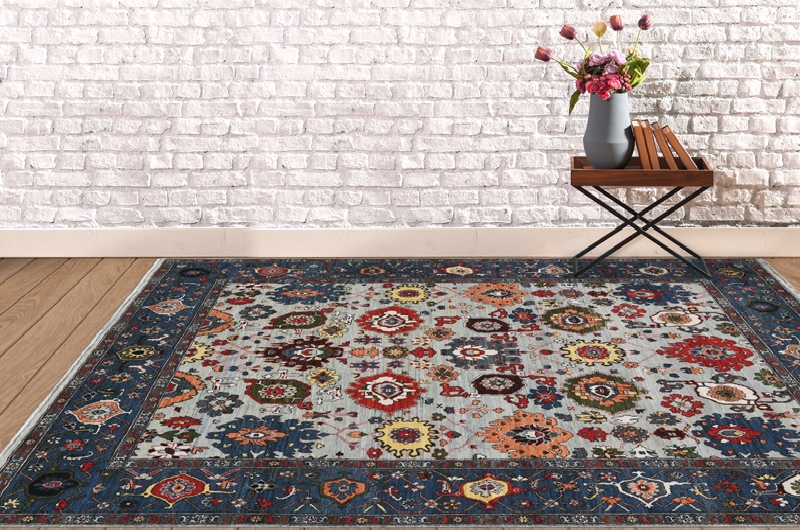
However, wool since years has been the classic choice for rug making because it offers resiliency with durability and cleanability, along with economy. In fact, all hand-woven rugs initially were made of wool, but, later silk thread use became popular in the 17th and 18th centuries which were then used as prayer rugs.
Soon after people learned the art to weave, they started making floor mats from grasses and other plant materials.
Here we share interesting evolution stories of rug making in different parts of the globe.
1. Rug-era started from Egypt: Although the exact account of rug making is not found anywhere in ancient documents, but the textile fragments dating back to several thousand years have been discovered across Asian continent which confirm that the first fabric floor coverings originated in Asia.
However, it was Egypt which is being credited for starting the rug era in around 3000 B.C. Thereafter, came improvements in weaving and designs leading to the evolution of rug era.
2. The first fabric made with pile: In around 400 BC came the earliest known fabric which was made with pile. It was named as Pazyryk rug which had pile fabrics made of materials which consisted of ordinary weave’s backing with extra threads that were knotted to form a raised surface.
3. India and rug making in 12th century: India witnessed the start of weaving pile rugs somewhere before the 12th-century AD and soon it spread to the Eastern part of the globe. The pile fabrics knotted by hand came up in the Orient (now Sri Lanka). These rugs reached Europe in around 1200 AD via crusaders travelling to Middle East.
4. Hand knotted rugs in Spain: The 13th century witnessed the making of hand-knotted rugs in Europe by the Arabs of southern Spain. The process of Rug was quite widespread, as the Moors who conquered France, had reportedly set-up many rug factories there.
5. Rug making came up as flourishing business in 14th and 15th century: It was in 14th and 15th century that rug making became a flourishing business in Persia. The business touched new heights in16th century. Rich colours and patterns came up in Isfahan which became centre of rug industry in Persia. These rugs and the rugs made in turkey were then imported to western Europe.
6. Rug Making in England: The process of rug making entered England in 1500 under the rule of King Henry IV. During his tenure from 1553 to 1610, a group of Persian weavers left Ishahan and went to Paris in Louvre Palace.
7 Rug Making in France: A carpet industry came up in France in 1628. The location of this factory although was a former soap factory situated at Chaillot, France. Here French weavers learnt the art of creating vibrant coloured rugs on beautiful motifs.In fact, Tapestry rugs were beautifully crafted in a small town in central France, called as Aubusson. Since then, it was become the carpet’s trade name. Later, Brussels emerged as an important center of tapestry in the 16th century. Later, it became as one of the principal sources of floor tapestries by the 18th century.
8. Rug making in England: It was around 1700 when England became a centre of European rug and carpet industry. The power loomed area rug was developed in 1780 here.
9. Flat-woven fabrics preferred in 19th century: Flat-woven fabrics were preferred in rug making in the 19th century in the West as it was quite affordable. Eventually, the hand knotted rugs which were expensive could not have been afforded by all segments. However, its demand continued soaring in the 19th century as well and they were preferred as floor covering in rooms. Mostly, English, Italian and French furniture were used as floor covering.
10: Machine made rugs entered in 20th century: The 20th century era witnessed the coming up of machine made rugs in single colour or else in overall patterns. With this style, it became easier for decorators to merge one carpet colour into a room scheme. It was here that demand for bold and complicated designs went low.
11: Introduction of tufting machine in 1950s: The era of 1950 saw the coming of tufting machine in carpeting. Initially, US became a hub of handmade tufted rug and carpets however eventually, spread to other parts of the world as well.
Presently, rugs come in varying styles and are made up by varying processes too. As the flooring styles of the houses are changing, so are carpet styles changing. Wood, laminate, stone, marble and tiles in our rooms and offices are decorated with these varying kinds of rugs, either hand knotted or hand tufted. Now, they come in diverse shapes and sizes to fit into the diverse needs and decorating styles of consumers.